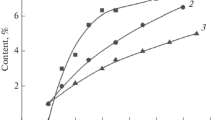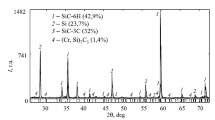Conclusions
In the initial stages of heat treatment of H2SiO3 and sucrose a mixture of highly dispersed defective SiO2 particles and carbon material is formed. Then as the result of contact interparticle interaction of a radical character disintegration (activation) of the carbon particles and envelopment of them by a layer of SiO2 accompanied by deformation of the Si-O-Si bonds occur. Filling of the pores of the carbon material with silicon oxide creates in subsequent higher temperature treatment favorable conditions for formation of SiC. The particles formed as the result of the relatively low-temperature solid-state reaction are non-uniform in composition. Their core consists of uninteracted carbon and after it follow a layer of silicon carbide and an outer layer of SiO2. A switch to the area of high synthesis temperature makes it possible to approach a stoichiometric composition of the silicon carbide.
Similar content being viewed by others
Literature cited
T. Ya. Kosolapova, T. V. Andreeva, T. S. Bartnitskaya, et al., Nonmetallic Refractory Compounds [in Russian], Metallurgiya, Moscow (1985).
A. A. Serebrennikov and V. A. Kravchenko, The Thermodynamics and Kinetics of Reduction of Metals [in Russian], Nauka, Moscow (1972), pp. 47–49.
I. S. Kulikov, Thermal Dissociation of Compounds [in Russian], Metallurgiya, Moscow (1969).
I. V. Ryabchikov, A. V. Gorokh, M. S. Khrushchev, et al., “A mechanism of reduction of silica by carbon,” Izv. Akad. Nauk SSSR, Met., No. 4, 38–42 (1966).
K. A. Akhmed-zade, V. V. Baptizmanskii, V. A. Zakrevskii, et al., “Paramagnetic centers formed in mechanical failure of silicon dioxide,” Fiz. Tverd. Tela,14, No. 2, 422–426 (1972).
V. A. Radtsig and A. V. Bystrikov, “An investigation of chemically active centers on the surface of quartz by the electron paramagnetic resonance method,” Kinet. Ratal.,19, No.3, 713–718 (1978).
A. G. Vlasov, A. F. Pozubenkov, N. A. Sevchenko, et al., The Infrared Spectra of Alkaline Silicates [in Russian], Khimiya, Leningrad (1970).
V. M. Samoilov, S. M. Rumyantsev, B. G. Ostronov, et al., “An investigation of the interphase transformations in petroleum tar by the electron paramagnetic resonance method,” Khim. Tverd. Topliva, No. 2, 35–38 (1983).
V. M. Samoilov, A. S. Kotosonov, and B. G. Ostronov, “An investigation of the features of the molecular structure of carbonized carbon materials by the electron paramagnetic resonance method,” ibid., No. 3, 135–138 (1985).
V. A. Radtsig, “The structure and reactivity of defects in mechanically activated solids,” Author's Abstract of Doctoral Thesis, Chemical Sciences, Moscow (1985).
K. E. Makhorin and A. M. Glukhomanyuk, The Production of Carbon Adsorbents in a Fluidized Bed [in Russian], Naukova Dumka, Kiev (1983).
A. S. Fialkov, Carbon-Graphite Materials [in Russian], Énergiya, Moscow (1979).
Author information
Authors and Affiliations
Additional information
Translated from Poroshkovaya Metallurgiya, No. 9(321), pp. 57–62, September, 1989.
Rights and permissions
About this article
Cite this article
Vlasova, M.V., Kakazei, N.G., Minakov, V.N. et al. Formation of silicon carbide in the reaction of reduction of silica by carbon. Powder Metall Met Ceram 28, 718–723 (1989). https://doi.org/10.1007/BF00797533
Received:
Issue Date:
DOI: https://doi.org/10.1007/BF00797533




